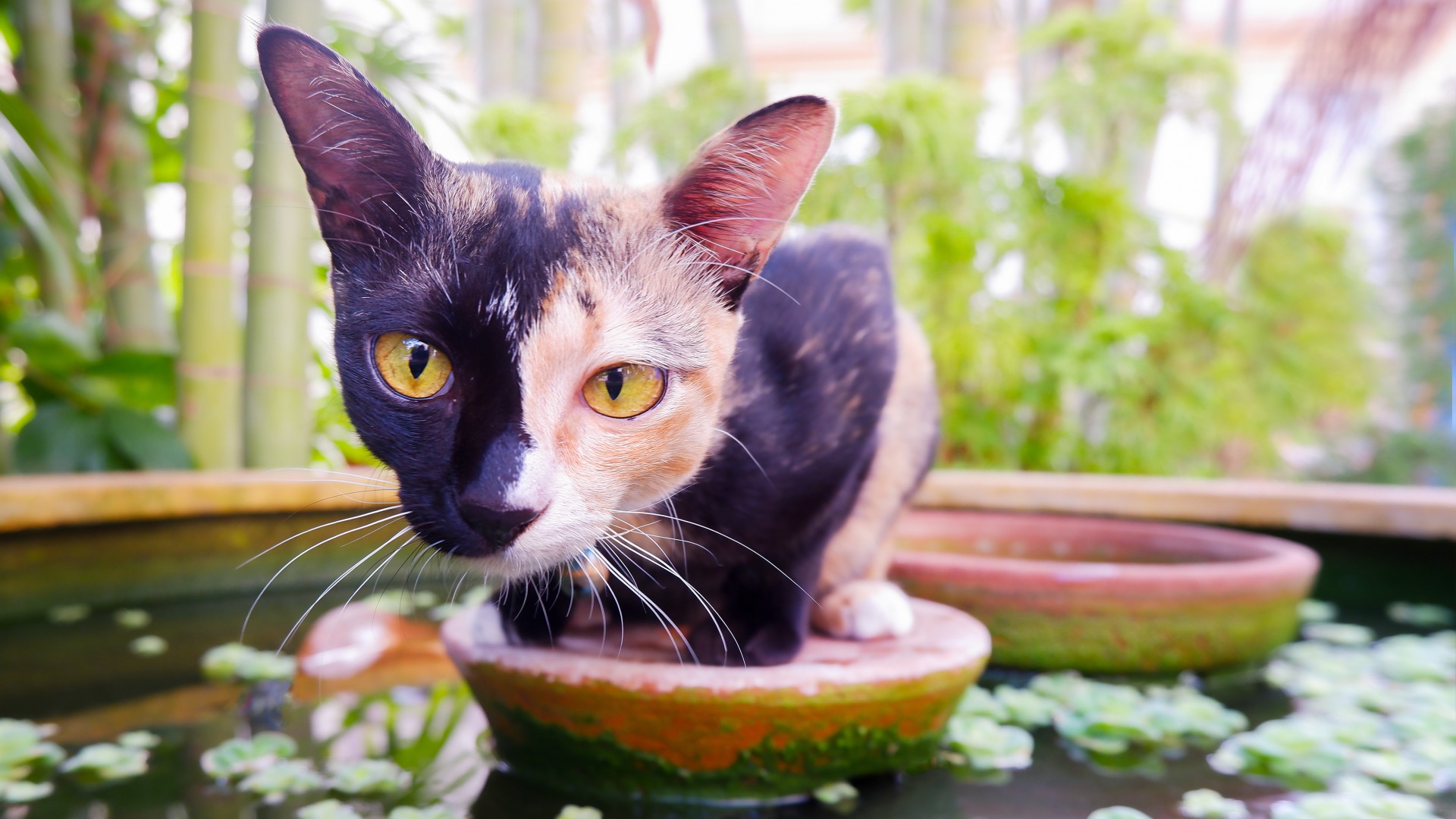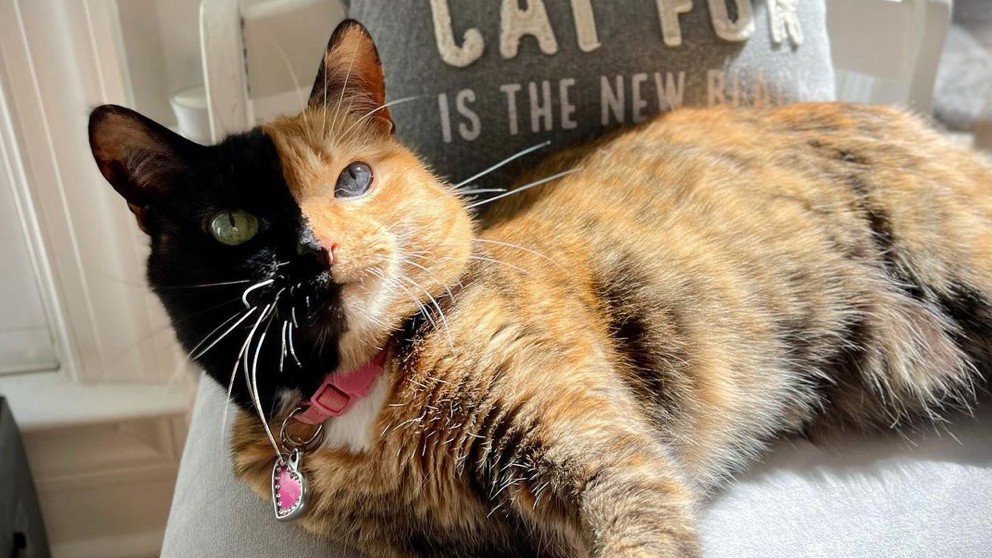Chimera cat: Everything you need to know about this captivating kitty
From how they get their markings to the most famous felines of the bunch, these chimera cat facts leave no stone unturned

Looking for some chimera cat facts to help you better understand this mysterious split-faced feline? You’ve come to the right place. With a love of play that only the best cat toys can satisfy and a sweet and gentle nature, these bi-colored kitties make charming companions.
Chimera cats have long fascinated us with their unique looks and charming personalities, and just like our facts about orange tabby cats revealed more than a few surprises, there’s plenty about the chimera cat to keep you captivated.
According to Greek mythology, a chimera is a monstrous, three-headed, fire-breathing creature who’s an animal hybrid, with a lion’s head, sat atop a goat’s body with the tail of a dragon that is sometimes finished off with a snake’s head. Don’t let that put you off though, a chimera in the feline world is something altogether different.
Breathtaking in a gorgeous, rather than scary way, the chimera cat’s stunning looks are caused by the fusion of several fertilized eggs, which means they carry different sets of DNA. It’s this mixing of distinct genomes that result in chimera cats sporting patterns that can be incredibly striking.
If you have a chimera cat or are thinking of getting one, the chimera cat facts below will fill you in on everything you need to know about this unique kitty. Plus, we introduce you to three of the most famous chimera cats in the world - including one who has amassed more than 2 million Instagram followers.
What is a chimera cat?
While you may not have heard of the term ‘chimera cat’, if you’re as big a lover of the feline fur babies of this world as we are, then it’s likely you may have come across a chimera cat before without realizing it.
In simple terms, a chimera cat is one who is born with a certain color on one part of their face and/or body and a different color on the rest of their face and/or body. These two colors are usually orange and black, but varying shades of brown are possible too.
Get the best advice, tips and top tech for your beloved Pets
If you’ve ever looked closely at a chimera cat, you’ll notice that the line that separates the two colors from one another is often uncannily straight and these sharply divided colors can make it look like mother nature took two different cats and glued them together.
Chimera cats have two sets of DNA
A chimera cat is one cat that started out as two, so you can think of these felines as being their own identical twin. Early on in their mothers womb, a pair of embryos fused together giving the chimera cat two sets of DNA - their own and that of another embryo.
The way that this mixed DNA will present will differ from feline to feline. Some chimera cats will be born with slight color differentiations that are barely noticeable, others with mild color differences that give them a mottled look, and some with dramatic differences that give them their striking split-faces.
Some chimera cats will have different colored eyes

Some chimera cats will be born with the most beautifully mismatched eyes, a phenomenon known as heterochromia which is the result of the two sets of DNA that these cats carry. This usually results in one amber or green colored eye and one blue colored eye, although just like the color of chimera cats themselves, this can differ.
They’re not the same as a tortoiseshell cat
Chimera cats often get mistaken for tortoiseshell or calico cats and here’s where things start to get slightly tricky. Most of these cats are not chimera cats, but there are a few who will be and it all comes down to gender.
Most tortoiseshell and calico cats are female and while they can look like a chimera, most are not. However, occasionally a litter of tortoiseshell or calico cats can produce a male and these male cats will often be chimera cats.
So, how does that all come to be? Well, female cats carry the XX sex chromosomes while males carry the XY sex chromosomes. Mother cats can only pass along the X chromosome to their kittens, but the father cat can contribute an X or a Y. If both contribute an X, then the kitten is a female (XX), if the father contributes a Y, then the kitten is born male (XY).
The gene for a calico or tortoiseshell cat is only carried on the X chromosome and the Y chromosome doesn’t carry it, meaning calico and tortoiseshell cats are almost always female. But, occasionally, two embryos fuse together (like with the chimera cat) and if the kitten is born male this fusion creates an extra X chromosome that makes them chimera.
Geneticists believe chimera cats are rare
While a lot of cats get passed off as being chimera, Columbia University Professor of Genetics and Development Virginia Papaioannou believes that in most cases, they’re unlikely to be.
“A chimera … is a composite individual that was made up of cells from at least two different original embryos. If they fuse together early enough, they will become a single organism whose genetic input is from two completely different individuals. In a mosaic, there’s only one individual and it just happens to have different genetic components active in its cells. A chimera would be a much more unusual and unlikely event.”
Papaioannou believes that most cats that are mistaken for chimera cats are really just very striking examples of calico cats.
Famous chimera cats
If you’ve been on social media this past decade and follow any cat-related accounts, it’s likely that you may have crossed paths with at least one of the famous felines below. But, just in case you haven’t met them yet, here’s three chimera cats that have taken the world by storm.
1. Venus
A post shared by Venus the Two Face Cat (@venustwofacecat)
A photo posted by on
With 2.2 million followers on Instagram, 13-year-old Venus the two-faced cat has been a social media darling for years and is quite possibly the most famous feline on the planet. With her amazing black and orange face that’s offset with one green and one blue eye, Venus is quite simply stunning, but not everyone is convinced she’s a chimera cat.
Because female cats already have two X chromosomes, Leslie Lyons, a professor at the University of California, Davis, who studies the genetics of domestic cats, says that while Venus is incredibly rare, she could sport that coat without an embryo fusion taking place.
So, if Venus isn’t a chimera, how exactly did she get the distinct coloring split on her face? Lyons says it could just be luck, the result of the black coloration being activated only in cells on one side of the face and the orange coloration being activated only on the other side of the face before the two patches merged in the middle.
“She is a bit of a mystery,” Lyons explains with the only way to know for certain being to give Venus a DNA test. We have a feeling this much-loved feline won’t be all that worried about whether she’s technically a chimera or not - after all, with a large following and her own merchandise line, Venus appears to be doing pretty well for herself regardless.
2. Quimera
A post shared by Quimera twofacedcat (@gataquimera)
A photo posted by on
If Venus had a twin, it would most certainly have been Quimera who looks almost like a mirror image of Instagram’s most famous feline.
While she may not have the same mammoth following as the kitty that has come before her, Quimera still has over 80,000 loyal fans on Instagram.
3. Narnia
A post shared by 🖤💙 AMAZING NARNIA Double Face (@amazingnarnia)
A photo posted by on
With close to 300,000 followers on Instagram, Narnia has a completely different look to Venus and Quimera, sporting a split black and gray face atop a black body with white tufts of fur on her chest.
The British Shorthair was born in 2017 and resides in France and her majestic name is befitting of her otherworldly appearance.

Kathryn is a freelance writer who has been a member of the PetsRadar family since it launched in 2020. Highly experienced in her field, she's driven by a desire to provide pet parents with accurate, timely, and informative content that enables them to provide their fur friends with everything they need to thrive.
Kathryn works closely with vets and trainers to ensure all articles offer the most up-to-date information across a range of pet-related fields, from insights into health and behavior issues to tips on products and training.
When she’s not busy crafting the perfect sentence for her features, buying guides and news pieces, she can be found hanging out with her family (which includes one super sassy cat and a kitten), drinking copious amounts of Jasmine tea and reading all the books.
She has written for a range of publications, including Fit&Well, Top Ten Reviews, LiveScience, Goodto, and Product Hunt.
